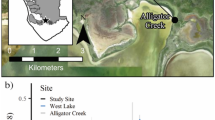Abstract
The objective of this study was to understand the main factors controlling salt marsh plant species structure and dynamics. So, we determined plant cover and composition across a permanent transect, 450 m long and 1 m wide, defined in 1951 in Corroios salt marsh, in the Tagus estuary (Portugal) and we characterized the physicochemical variables every 50 m along this transect. Based on those results we discuss the dynamic and evolution of salt marsh vegetation during the last 50 years comparing former and recent data. The results showed that differences in salinity and flooding were determinant factors in plant species composition and distribution along the studied transect. In addition, long-term variations of these factors as a consequence of vertical accretion and sea level rise seem to be responsible for the evolution in plant structure and vegetation zonation patterns, during the last 50 years in the Tagus estuary salt marshes.





Similar content being viewed by others
References
Adams, D. A., 1963. Factors influencing vascular plant zonation in North Carolina salt marshes. Ecology 44: 445–456.
Braun-Blanquet, J., 1979. Fitosociologia (Translated by Oriol de Bolós). Blume, Madrid.
Brinson, M. M., R. R. Christian & L. K. Blum, 1995. Multiple states in the sea-level induced transition form terrestrial forest to estuary. Estuaries 18: 648–659.
Caçador, I., 1986. Estrutura, função e dinâmica da vegetação das margens do estuário do Tejo [Trabalho de síntese para admissão às Provas de Aptidão Pedagógica e Capacidade Científica]. Faculdade de Ciências da Universidade de Lisboa, Lisbon.
Caçador, I., I. Mascarenhas & P. Mascarenhas, 1999. Biomass of Spartina maritima, Halimione portulacoides and Arthrocnemum fruticosum in Tagus estuary salt marshes. In Lieth, H., M. Moschenko, M. Lohmann, H.-W. Koyro & A. Hamdy (eds), Halophyte uses in different climates I - ecological and ecophysiological studies. Backuys Publishers, Leiden.
Caçador, I., C. Vale & F. M. Catarino, 1996. Accumulation of Zn, Pb, Cu and Ni in sediments between roots of the Tagus estuary salt marshes, Portugal. Estuarine, Coastal and Shelf Science 42: 393–403.
Cooper, A., 1982. The effects of salinity and waterlogging in the growth and cation uptake of salt marsh plants. New Phytologist 90: 263–275.
Earle, J. C. & K. A. Kershaw, 1988. Vegetation patterns in James Bay costal marshes. III. Salinity and elevation as factors influencing plant zonations. Canadian Journal of Botany 67: 2967-2974.
Esteves de Sousa, A., 1951. Notas ecológicas. Acerca da sub-halosérie da região salgadiça litoral, entre Corroios e Talaminho. Revista da Faculdade de Ciências, 2ª série C 1: 161-188.
Jensen, A., 1980. Seasonal changes in near IR reflectance ratio and standing crop biomass in a salt marsh community dominated by Halimione portulacoides. New Phytologist 86: 57–68.
Leeuw, J., W. Munck, H. Olff & J. P. Bakker, 1993. Does zonation reflect the succession of salt-marsh vegetation? A comparison of an estuarine and a coastal bar island marsh in The Netherlands. Acta Botanica Neerlandica 42: 435–446.
Long, S. P. & C. F. Mason, 1983. Saltmarsh ecology. Blackie, Glasgow.
Mello, A. C., A. I. Correia, M. I. Caçador, M. I. Ramos & F. M. Catarino, 1977. Aspectos da estrutura e dinâmica das comunidades vegetais do salgado de Corroios. Bases para a sua protecção. Publicações da Liga para a Protecção da Natureza 23: 41–49.
Mendelssohn, I. A. & E. D. Seneca, 1980. The influence of soil drainage on the growth of salt marsh cordgrass Spartina alterniflora in North Carolina. Estuarine and Coastal Marine Science 11: 27–40.
Miller, W. D., S. C. Neubauer & I. C. Anderson, 2001. Effects of sea level disturbances on high salt marsh metabolism. Estuaries 24: 357–367.
Nixon, S. W., 1982. The ecology of New England high salt marshes: a community profile. U.S. Fish and Wildlife Service, Office of Biological Services, Washington.
Rogel, J. A., F. A. Ariza & R. O. Silla, 2000. Soil salinity and moisture gradients in Mediterranean salt marshes of Southeast Spain. Wetlands 20: 357–372.
Roozen, A. J. M. & V. Westhoff, 1985. A study on long term salt-marsh succession using permanent plots. Vegetatio 61: 23–32.
Rozema, J., P. Leendertse, J. Bakker & H. van Wijnen, 2000. Nitrogen and vegetations dynamics in European salt marshes. In Weinstein, M. P. & D. A. Kreeger (eds), Concepts and controversies in tidal marsh ecology. Kluwer Academic Publishers, Dordrecht, 469–491.
Ter Braak, C. J. F., 1988. CANOCO – a Fortran program for canonical community ordination by partial detrended canonical correspondence analysis, principal components and redundancy analysis. Agricultural and Mathematical Group, Wageningen.
Ter Braak, C. J. F. & I. C. Prentice, 1988. A theory of gradient analysis. Advances in Ecological research 18: 271–317.
Valiela, I. & J. M. Teal, 1979. The nitrogen budget of a salt-marsh ecosystem. Nature 280: 652–656.
Waisel, Y., 1972. Biology of halophytes. Academic Press, New York.
Wijnen, H., 1999. Nitrogen dynamics and vegetation succession in salt marshes. [Ph.D Thesis]. University of Groningen, Groningen.
Woerner, L. S. & C. T. Hackney, 1997. Distribution of Juncus roemerianus in North Carolina tidal marshes: the importance of physical and biotic variables. Wetlands 17: 284–291.
Zedler, J. B., 1977. Salt marsh community structure in the Tijuana estuary, California. Estuarine and Costal Marine Science 5: 39–53.
Acknowledgements
This study was supported by POCTI/PNAT/BIA/15035/99 and Programa Operacional Ciência, Tecnologia, Inovação do Quadro Comunitário de Apoio III.
Author information
Authors and Affiliations
Corresponding author
Rights and permissions
About this article
Cite this article
Caçador, I., Tibério, S. & Cabral, H.N. Species zonation in Corroios salt marsh in the Tagus estuary (Portugal) and its dynamics in the past fifty years. Hydrobiologia 587, 205–211 (2007). https://doi.org/10.1007/s10750-007-0681-y
Issue Date:
DOI: https://doi.org/10.1007/s10750-007-0681-y




